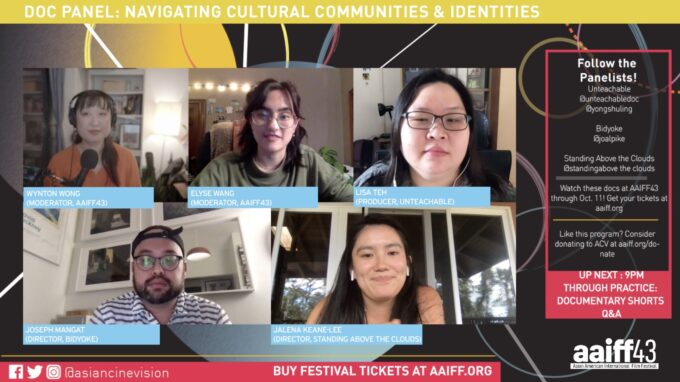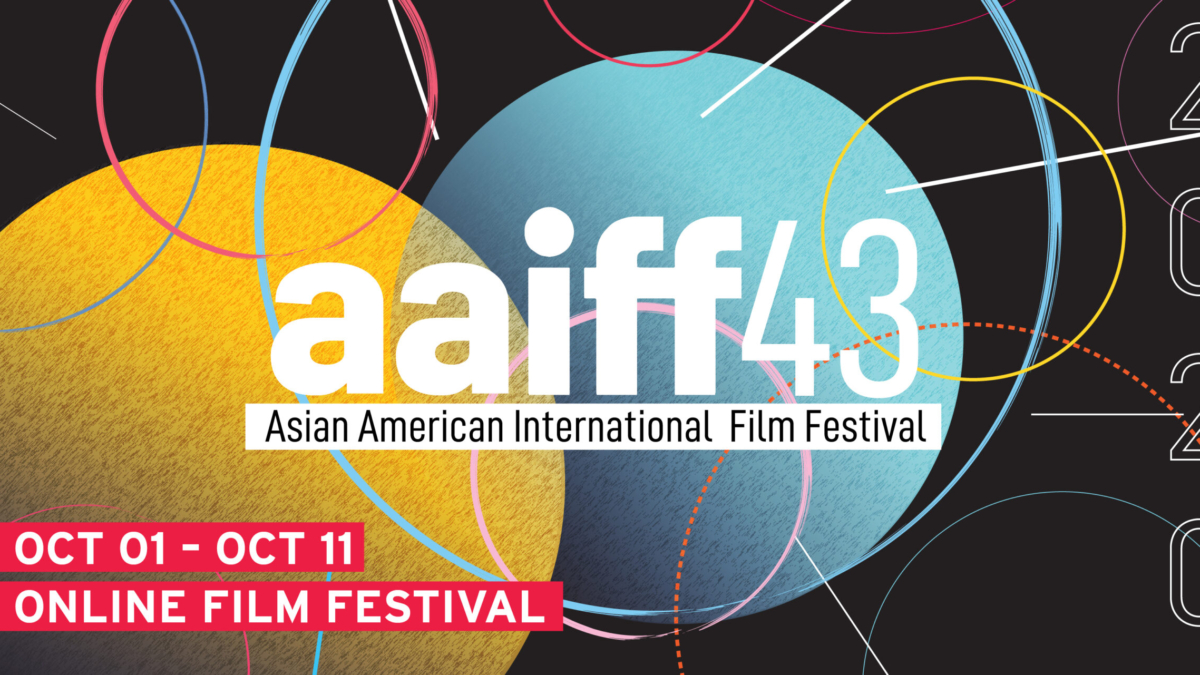Written By: Kano Umezaki
In the popular cinematic imagination, Asians and Pacific Islanders linger as exotic backgrounds, simultaneously commodified and expropriated in the name of “representation.” To challenge against these colonial myths that ceaselessly shape the conditions of our visibility, Asian Pacific Islander documentary filmmakers use cinema as a site of cultural reclamation. During last Sunday’s AAIFF43 panel, Lisa Teh (“Unteachable”), Joseph Mangat (“Bidyoke”) and Jalena Keane-Lee (“Standing Above the Clouds”) came together to discuss the moral trepidations of the documentary filmmaking process, as well as the hopes placed in the genre for grounding API communities.
Moderated by Wynton Wong, Asian Cinevision (ACV) Program Manager, and Elyse Wang, ACV Webmaster, the panelists each spoke about their relationship to the communities they depicted on-screen. For the making of “Bidyoke” –– a film about a beloved Filipino karaoke-restaurant in National City, California –– Mangat shared his experience going to the Gaspo Resto & Karaoke bar everyday for a month, eventually becoming a part of the group of Filipino regulars who frequented by. “I wanted to make something that I haven’t seen showcased with Filipino Americans and Filipino immigrants,” Mangat said. In just twenty-seven minutes, he manages to capture intimate portraits of the people who came to Gaspo Resto, ultimately unspooling how integral karaoke is to the Filipino community. Sadly, a few months before “Bidyoke” was released, Gaspo Resto & Karaoke bar closed down, turning the film into a sort-of time capsule for the Filpino community in National City.
Jalena Keane-Lee also shared her process making “Standing Above the Clouds,” a short film that follows Native-Hawaiian mother-daughter activists as they stand to protect their sacred Mauna Kea from the colonial construction project of the world’s largest telescope. “My mom raised me knowing that not only is the personal political, but also there’s nothing more political than how you raise your kids,” Jalena shared. “How we’re taught, what we learn about the world –– that’s everything when it comes to how we perceive ourselves in the world around us.” When depicting Indigenous women activists, Jalena shared how she was very intentional with centering their agency. “One thing Auntie Pua would talk about is: it’s our art but it’s their life. And so that’s something we take seriously.”
Echoing both Mangat and Keane-Lee, Teh shared the importance of being transparent throughout the filmmaking process. Her film, “Unteachable,” centers the voices of Singaporean children who’re relegated to the bottom of the academic hierarchy. In order to proceed with the filmmaking process, Teh shared how she and director Shuling Yong had to meet with the students’ parents beforehand. “We introduced who we were, what we were doing; and then we showed them clips of what we had filmed of their child in classrooms. And we also tried to invite them to rough-cut screenings to make sure they felt [their children] were accurately and fairly represented.”

As the panelists implicitly noted, documentary filmmaking is a demanding praxis. There’s a moral obligation to speak in proximity so as to not assume a position of authority. Vietnamse feminist and filmmaker, Trinh T. Minh-ha, infamously coined this practice “speaking nearby.”
The panelists each recognize that filmmakers are inevitably positioned between the camera and its subjects, making it so they must constantly contest their relationship and boundaries with the people who populate the film. As Keane-Lee shared: “Wherever I choose to point the camera, every question that I’m asking, [choosing] these people [as] the ones in it, whose being shown as an expert, who are we getting the kind of intimacy with that builds emotional connection –– like all of that is me.”
Teh added that the process of documenting “nearby” is difficult, specifically at the stage of editing. “Maribel, [the editor], and I had some intense deliberations on some of [the footage]. We asked ourselves these tough questions: Why are we putting this clip in. Is it for sensationalization? Does it move the story forward?” As both Keane-Lee and Teh shared, it’s crucial for documentary filmmakers to be aware of their postioniality so that, although they’re very close to their subjects, they’re not speaking on their behalf.
Documentaries, unlike other film genres, are also fabricated as beholders of truth; but as Mangat mentioned: “I wish we would get into more all the forms of documentary, like creative documentary and experimental documentary. Seeing documentaries as just an art form more-so than just something to get information.” To see documentaries as reality would be to assume a neutral language exists, when in actuality, no one is capable of being objective as positions of witness.
Keane-Lee added to Mangat’s point by sharing: “I feel like this idea of being ‘unbiased’ or ‘objective’ is something that needs to be let go of. We can acknowledge that ‘objectivity’ is often times rooted in a white supremacist framework.” Both Keane-Lee and Mangat agreed that documentary film-making is an art that leans on fiction. An ‘objective’ gaze doesn’t exist, but is often times pronounced to exist when the white supremacist gaze is naturalized.
Keane-Lee also shared the radical political-cultural inception of the Asian American identity during the sixties: “It’s interesting even thinking about what ‘Asian American’ means and how that was a political framework to unite us when everything was happening with the Third World Liberation Front at SF State.” Keane-Lee’s invocation of the radical inception of the Asian American identity raises a crucial, timely question: What constitutes Asian American cinema? Considering the pan-ethnic identity was created as a political tool to mobilize Asian American’s against the white supremacist settler-colonial state, does Asian American cinema have to speak to its radical, ethnic roots? Or is representation enough?
To even further expand, since Asian American Pacific Islander (AAPI) is a Western-imposed identity made of disparately different colonial histories –– especially in regards to the overshadowing of the Pacific Islander community –– navigating what documentaries should mean to our respective and shared communities can invoke confusion. Because Pacific Islanders and Asian Americans face starkly different struggles concerning land sovereignty and colonization, many Pacific Islander activists even argue that PI’s should be separated from the wider Asian/Asian American category all together.
As a native Singaporean, Teh had her own take on the topic of identity and its intersections with community. “I do hope that Singaporeans consume more Singaporean films. We are heavily influenced by blockbusters from the U.S. that take up most of our screens in Singapore. But I hope that we’ll be interested in more of our own local stories. Even trying to discover or find out what it means to be Singaporean.” Since Singapore is a multi-ethnic state whose national identity is essentialized by its majority Sino population, Teh finds it important to visibilize racialized minorities who are often ignored by society.
Despite the restriction of borders and boundaries with COVID-19, the panelists remain diligent with their creative projects. Mangat is currently in the midst of making “Holy Craft,” a feature-length documentary based in the Philippines which recently won the Docs-In-Progress award at Cannes Docs. Teh is working on a documentary about the Special Forces in Singapore while also writing for preschool television programs at the award-winning animation company, Omens Studios. Keane-Lee is turning her short film, “Standing Above the Clouds,” into a full-feature documentary –– that’ll hopefully come out within two years –– while also working on a documentary about the Chinese diaspora in Havana, Cuba.
Though the API community is constantly under a state of flux, reshaping its identities according to their racializations, Asian Pacific Islanders have never stopped creating. We have never stopped naming our resistance through our art.

